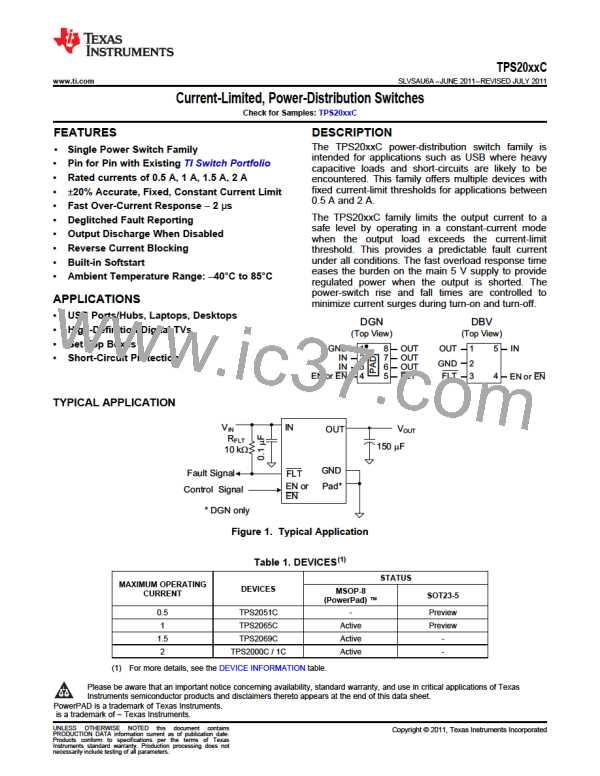TPS20xxC
www.ti.com
SLVSAU6A –JUNE 2011–REVISED JULY 2011
DETAILED DESCRIPTION
The TPS20xxC are current-limited, power-distribution switches providing between 0.5 A and 2 A of continuous
load current in 5 V circuits. These parts use N-channel MOSFETs for low resistance, maintaining voltage
regulation to the load. They are designed for applications where short circuits or heavy capacitive loads will be
encountered. Device features include enable, reverse blocking when disabled, output discharge pulldown,
overcurrent protection, over-temperature protection, and deglitched fault reporting.
UVLO
The undervoltage lockout (UVLO) circuit disables the power switch until the input voltage reaches the UVLO
turn-on threshold. Built-in hysteresis prevents unwanted on/off cycling due to input voltage drop from large
current surges. FLT is high impedance when the TPS20xxC is in UVLO.
ENABLE
The logic enable input (EN, or EN), controls the power switch, bias for the charge pump, driver, and other
circuits. The supply current is reduced to less than 1 µA when the TPS20xxC is disabled. Disabling the
TPS20xxC will immediately clear an active FLT indication. The enable input is compatible with both TTL and
CMOS logic levels.
The turnon and turnoff times (tON, tOFF) are composed of a delay and a rise or fall time (tR, tF). The delay times
are internally controlled. The rise time is controlled by both the TPS20xxC and the external loading (especially
capacitance). The fall time is controlled by the TPS20xxC, the loading (R and C), and the output discharge (RPD).
An output load consisting of only a resistor will experience a fall time set by the TPS20xxC. An output load with
parallel R and C elements will experience a fall time determined by the (R × C) time constant if it is longer than
the TPS20xxC’s tF.
The enable should not be left open, and may be tied to VIN or GND depending on the device.
INTERNAL CHARGE PUMP
The device incorporates an internal charge pump and gate drive circuitry necessary to drive the N-channel
MOSFET. The charge pump supplies power to the gate driver circuit and provides the necessary voltage to pull
the gate of the MOSFET above the source. The driver incorporates circuitry that controls the rise and fall times of
the output voltage to limit large current and voltage surges on the input supply, and provides built-in soft-start
functionality. The MOSFET power switch will block current from OUT to IN when turned off by the UVLO or
disabled.
CURRENT LIMIT
The TPS20xxC responds to overloads by limiting output current to the static IOS levels shown in the Electrical
Characteristics table. When an overload condition is present, the device maintains a constant output current, with
the output voltage determined by (IOS × RLOAD). Two possible overload conditions can occur.
The first overload condition occurs when either: 1) input voltage is first applied, enable is true, and a short circuit
is present (load which draws IOUT > IOS), or 2) input voltage is present and the TPS20xxC is enabled into a short
circuit. The output voltage is held near zero potential with respect to ground and the TPS20xxC ramps the output
current to IOS. The TPS20xxC will limit the current to IOS until the overload condition is removed or the device
begins to thermal cycle. This is demonstrated in Figure 11 where the device was enabled into a short, and
subsequently cycles current off and on as the thermal protection engages.
The second condition is when an overload occurs while the device is enabled and fully turned on. The device
responds to the overload condition within tIOS (Figure 6 and Figure 7) when the specified overload (per Electrical
Characteristics table) is applied. The response speed and shape will vary with the overload level, input circuit,
and rate of application. The current-limit response will vary between simply settling to IOS, or turnoff and
controlled return to IOS. Similar to the previous case, the TPS20xxC will limit the current to IOS until the overload
condition is removed or the device begins to thermal cycle. This is demonstrated by Figure 12, Figure 13, and
Figure 14.
Copyright © 2011, Texas Instruments Incorporated
13

 TI [ TEXAS INSTRUMENTS ]
TI [ TEXAS INSTRUMENTS ]